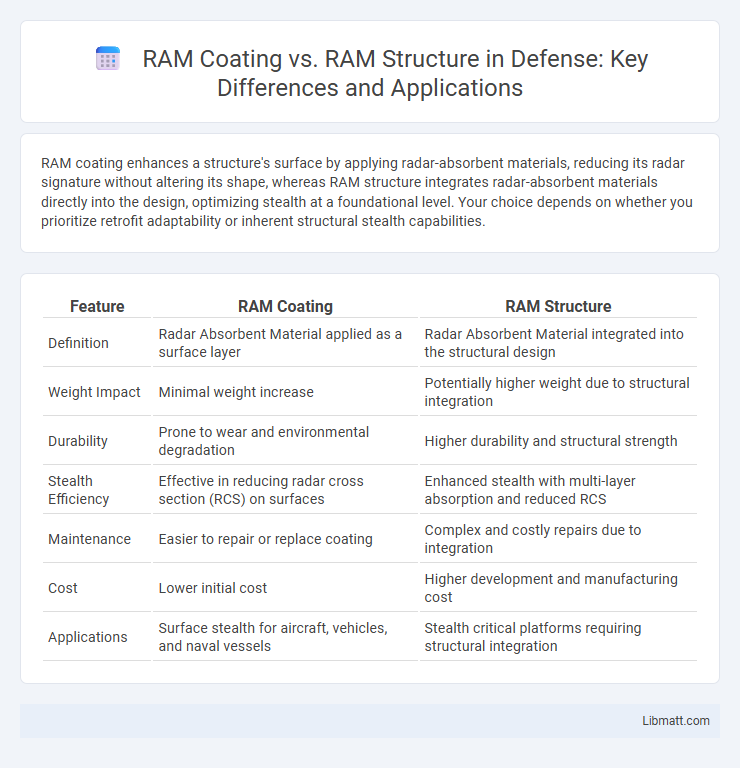RAM coating enhances a structure's surface by applying radar-absorbent materials, reducing its radar signature without altering its shape, whereas RAM structure integrates radar-absorbent materials directly into the design, optimizing stealth at a foundational level. Your choice depends on whether you prioritize retrofit adaptability or inherent structural stealth capabilities.
Table of Comparison
| Feature | RAM Coating | RAM Structure |
|---|---|---|
| Definition | Radar Absorbent Material applied as a surface layer | Radar Absorbent Material integrated into the structural design |
| Weight Impact | Minimal weight increase | Potentially higher weight due to structural integration |
| Durability | Prone to wear and environmental degradation | Higher durability and structural strength |
| Stealth Efficiency | Effective in reducing radar cross section (RCS) on surfaces | Enhanced stealth with multi-layer absorption and reduced RCS |
| Maintenance | Easier to repair or replace coating | Complex and costly repairs due to integration |
| Cost | Lower initial cost | Higher development and manufacturing cost |
| Applications | Surface stealth for aircraft, vehicles, and naval vessels | Stealth critical platforms requiring structural integration |
Overview of RAM Coating and RAM Structure
RAM coating involves applying a specialized material layer designed to absorb radar waves and reduce the radar cross-section of an object, enhancing stealth capabilities. RAM structure integrates radar-absorbent materials directly into the physical design and construction of an object, offering inherent radar signature reduction without relying on external layers. Your choice between RAM coating and RAM structure depends on the specific stealth requirements, durability, and application context of the platform.
What Is RAM Coating?
RAM coating refers to a protective layer applied over RAM modules to enhance durability and heat dissipation, improving overall performance and lifespan. Unlike the internal RAM structure, which involves the circuitry and architecture of memory cells, RAM coating focuses on physical protection and thermal management. High-quality coatings often use materials such as aluminum or specialized polymers to prevent overheating and physical damage.
What Is RAM Structure?
RAM structure refers to the physical and organizational design of random-access memory within a computer system, defining how memory cells are arranged and accessed to store and retrieve data efficiently. It includes components like memory cells, address decoders, sense amplifiers, and output drivers, which work together to enable rapid read and write operations. Optimizing RAM structure impacts overall system performance by reducing access time and increasing memory bandwidth.
Key Differences Between RAM Coating and RAM Structure
RAM coating involves a layer applied to the surface of a material to enhance durability, heat resistance, and corrosion protection, typically used in industrial applications. RAM structure refers to the internal composition or design of the material itself, affecting its mechanical strength, thermal conductivity, and overall performance. Key differences include the external protective role of RAM coating versus the intrinsic functional properties governed by the RAM structure.
Materials Used in RAM Coating
RAM coating typically uses materials such as iron ball paint, carbonyl iron, and ferrite particles to absorb electromagnetic waves and reduce radar signatures, enhancing stealth capabilities. These coatings are applied as thin layers on surfaces, making them lightweight and versatile for various platforms. Your choice of RAM coating materials influences the effectiveness of radar absorption and durability under operational conditions.
Materials Used in RAM Structure
RAM structures primarily use advanced composites such as silica-based ceramic tiles and carbon-carbon composites to withstand extreme heat and aerodynamic stress. Materials like fiberglass and phenolic resins are integrated into the surface coatings to enhance thermal insulation and reduce radar reflectivity. The combination of these materials ensures structural integrity and stealth capabilities in high-performance aerospace applications.
Performance Efficiency: Coating vs Structure
RAM coating enhances performance efficiency by providing a protective layer that reduces heat retention and minimizes electromagnetic interference, leading to faster data access and improved signal integrity. RAM structure directly impacts performance by determining the physical arrangement of memory cells, affecting latency and bandwidth through optimized circuit design and minimized electrical resistance. Combining advanced RAM coatings with efficient structural layouts maximizes overall memory speed and energy efficiency in computing systems.
Application Methods for RAM Coating
Application methods for RAM coating primarily include spray techniques such as air spraying, airless spraying, and electrostatic spraying, which ensure uniform coverage and strong adhesion on aerospace surfaces. These coatings are carefully applied in controlled environments to maintain optimal thickness and surface texture, enhancing Radar Absorbent Material effectiveness. Proper substrate preparation and curing processes are essential to maximize the coating's durability and electromagnetic wave absorption properties.
Design Considerations for RAM Structure
Design considerations for RAM structure emphasize optimizing material composition, thickness, and layering to enhance electromagnetic wave absorption. Precise control of impedance matching and structural geometry enables efficient attenuation across targeted frequency ranges. Incorporating advanced composites and gradational profiles improves durability and performance under varying environmental conditions.
Which Is Better: RAM Coating or RAM Structure?
RAM coating enhances surface durability and reduces friction, improving component lifespan in high-performance applications. RAM structure, involving the design and arrangement of memory modules, optimizes data processing speed and power efficiency in computing systems. Choosing between RAM coating and RAM structure depends on specific use cases, with coating favored for mechanical robustness and structure prioritized for computational performance.
RAM coating vs RAM structure Infographic

 libmatt.com
libmatt.com